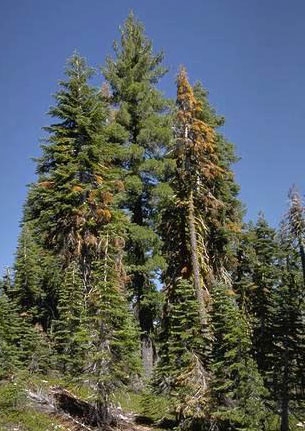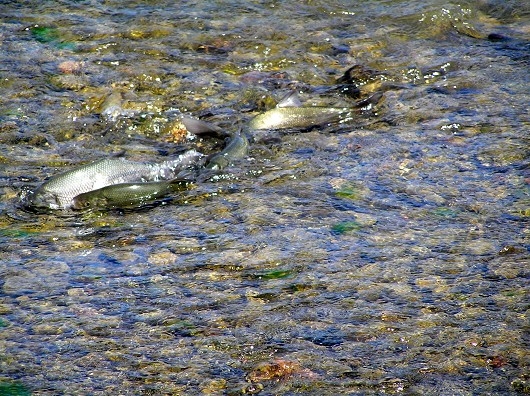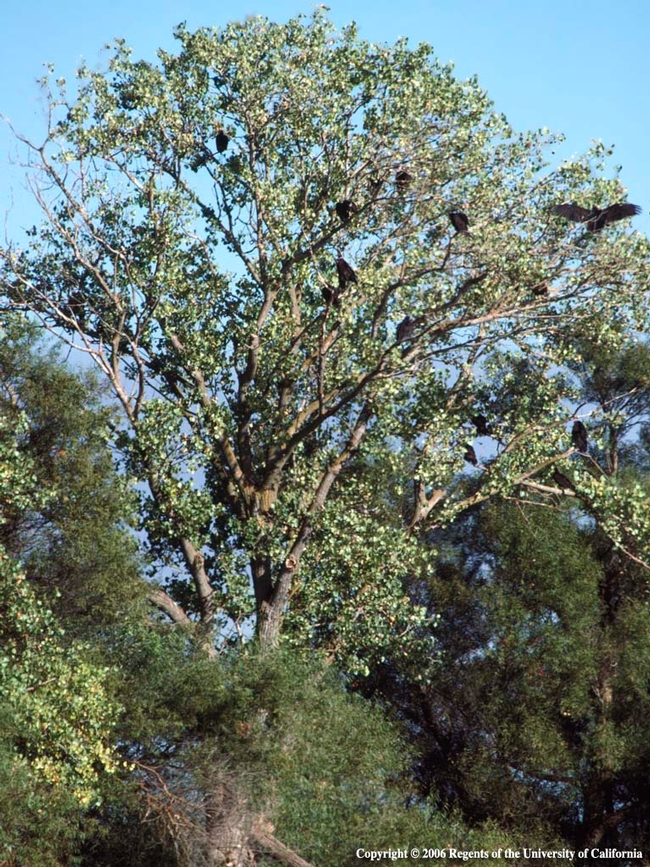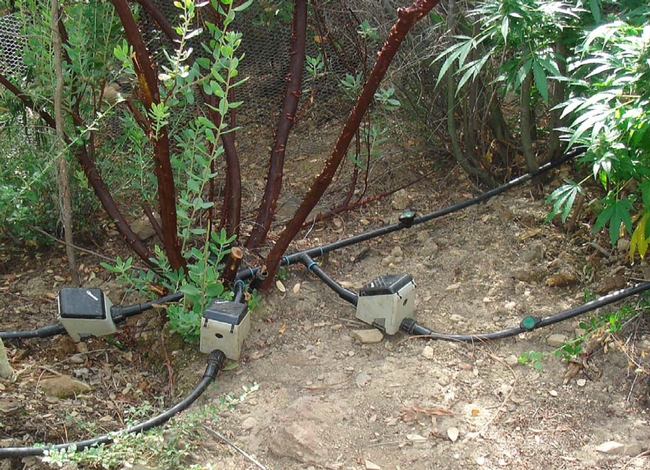Posts Tagged: Greg Giusti
Trees dying due to drought are prone to wildfire
Across California, pine trees that have been weakened by the drought are having trouble defending themselves from bark beetles, causing widespread tree death. The dead trees won't cause fires, but when ignited they will be hotter and be more difficult to control, according to articles that ran over the weekend in the Santa Rosa Press-Democrat and the Desert Sun.
“Statewide, it's horrific,” said Greg Giusti, UC ANR Cooperative Extension advisor.
Max Moritz, UC ANR Cooperative Extension specialist in fire ecology, described the combination of exceptionally low vegetation moisture and widespread plant deaths as "a double-barreled threat."
"On top of the dry conditions, it's been unusually hot in many, many parts of the state," Moritz said. "We do have a pretty exceptional fire season stacking up, or the potential for one."
The Los Angeles Times also covered the story earlier this month.
Scott Stephens, fire science professor at UC Berkeley, said fire suppression and harvesting have made forests more dense over the last 100 years. The increased density has made trees more vulnerable as they compete for limited amounts of water, with the weaker trees more susceptible to bark beetle infestations, he said.
“If the drought continues for another two years or longer, I expect this mortality to move throughout the state,” Stephens said. “Forests that once burned frequently with low-moderate intensity fire regimes are the most susceptible.”
The Clear Lake hitch get new protection
Introduced predatory and competitive fish species and low water flows in the hitch's spawning grounds have combined with other factors to throw hitch populations into decline, prompting its designation as a threatened species. With the new status, agencies can now solicit funds for stream and habitat improvements and any changes to the shoreline, tributaries and lake may only be made after carefully studying the potential impact on Clear Lake hitch.
“Anytime an animal gets listed, I believe it's an admission of failure on the part of society,” said Greg Giusti, UC Cooperative Extension natural resources advisor in Lake County. “We've been asleep at the switch.”
Giusti is mobilizing efforts to help the local residents, anglers and farmers deal with outcomes of the new designation.
Scientists determined the Clear Lake hitch was a distinct species in 1973. There are hitch in other Northern California lakes and waterways, but differences suggest the Clear Lake hitch took its form after geologic forces separated the lake from the Sacramento River watershed thousands of years ago.
The Clear Lake hitch spawn in creeks and streams in late winter and early spring. Eggs hatch in about seven days and a week later the free swimming young begin moving down stream. For 80 days the fish stay in marshy areas at the mouths of streams, feeding heavily on rice fly larvae. At about 2 inches in length, they move away from the shore into deeper water and, when mature, return to spawn in streams.
Pomo Indians traditionally harvested Clear Lake hitch in large numbers when free-flowing creeks and streams were teaming with spawning adults. The fish were dried and served as an important food source all year. Descendants of Native Americans wish to continue the practice.
According to Peter Moyle, professor in the Department of Wildlife, Fish and Conservation Biology at UC Davis, the fish were among the last native species in Clear Lake to be doing reasonably well until the early 1970s when three alien fishes became abundant in the lake - Florida largemouth bass, Mississippi silverside, and threadfin shad.
“The bass is a terrific game fish,” Moyle said. “The Florida bass was introduced to improve the fishery. However, they became very abundant and are voracious predators of hitch. Likewise, the silverside and shad likely prey on hitch larvae and compete with hitch for their zooplankton food.”
Clear Lake hitch have also been impacted by water extraction from the tributaries upstream, mainly for irrigation, plus the construction of bridges, dams and other structures in their spawning streams.
While in the past there were tens of thousands of Clear Lake hitch spawning in dozens of tributaries, in recent years, population has been reduced to a few thousand and they reportedly spawn in only two streams. Because of the low water flows in current drought conditions, Giusti said, there was virtually no Clear Lake hitch spawn at all in 2014.
'Overlooked' turkey vultures the center of UCCE research
To some, turkey vultures are repugnant scavengers that feed on road kill. But to Greg Giusti, they are an intriguing, unexplored scientific topic, said an article in the Ukiah Daily Journal.
"They aren't warm and cuddly so people aren't drawn to them," Giusti said. "My academic curiosity drew me in."
Giusti has discovered that the birds nest in cavities of old, long-dead oak trees.
"We have seen the vultures jump inside the hollow, the middle of the tree, some 8 to 10 feet down," Giusti said. "Since there is not sufficient diameter for them to fly up from the inside, we surmise that they shimmy up to the top. When the hatchlings are about a month old and able to fly, almost full size, they, too, must shimmy up to get out."
The UC Hopland Research and Extension Center hosts a public seminar, "Turkey Vultures in the Oaks: A Lovely Yet Maligned Bird," at 7 p.m. tonight in the Rod Shippey Hall, 4700 University Road, Hopland.
Pollute, poach, dewater: Legacies of illicit cannabis grows
While the legality of California’s medical marijuana dispensaries is being debated in courtrooms, a UC Cooperative Extension forestry and wildlands ecology advisor says there are a number of issues related to the unregulated land-use practices of illicit cannabis growing that have not been addressed.
“As a forest ecologist, I spend a lot of time outdoors, and I talk to thousands of people every year about forest-related subject matter,” says Greg Giusti. “And you can’t talk to anybody today on the North Coast without the topic of cannabis growing and cannabis impacts on land coming up.”
In Lake and Mendocino counties, Giusti performs research and shares information with public agencies and private landowners in relation to forest management and freshwater ecology on behalf of UC Cooperative Extension. Marijuana farming is not a topic that Giusti ever intended to address.
Effects on natural resources
Most of the data available about illicit cannabis grows is based on drug enforcement actions, specifically how many sites were busted and how many plants or pounds of plant material were seized. Giusti has gathered photographs and anecdotal evidence of the effects on natural resources of commercial-scale marijuana grows operated illicitly on public and private lands.
Some of the effects he has documented:
- illegal water controls (including dams, stream diversion and water storage)
- water pollution from petroleum, pesticide and fertilizer products
- pesticides applied without permits
- pesticides, fertilizers and other chemicals left behind
- indiscriminate fish and wildlife killing (including poisoning, trapping and poaching for food)
- human trash and waste left after camping
“It’s not this green industry that people talk about,” Giusti says. “They’re diverting water, they’re polluting streams, and there’s a portion who are poaching. We’re also seeing all of the negative effects of unregulated road building, unregulated construction and unregulated human inhabitation for months and months out in the woods.”
Giusti explained that some cannabis growers divert water from streams to store in large water bladders, prematurely lowering stream levels during critical times in the year.
“It's illegal to do, but at the same time you can drive up and down Highway 101 and easily buy these huge bladders,” he said.
He notes that local businesses are selling compost by the ton, rodenticide by the pallet, thousands of pairs of clippers and turkey bags in lots of 100.
“Mainstream businesses are supporting this underground industry,” Giusti said. “You don’t have to be growing cannabis to be making money off of it.”
Raising awareness
In 2010, Giusti organized two community workshops in Lake County to address the impacts of illicit cannabis land-use on forest resources, for a combined attendance of nearly 400 community members. Giusti has shared his results with the board of supervisors for Lake and Mendocino counties, local news media, local foresters and the staff of the North Coast Regional Water Quality Control Board.
“My intention was to initiate a communitywide discussion to ask, ‘Is this what you want to happen to your forests?’” Giusti said. “Up until now it's been talked about in hushed tones, and I wanted to initiate a dialogue out loud. Everybody has been whispering about it.”
The presentation he developed for those meetings continues to generate discussion. Most recently, he has presented to the North Coast Water Quality Control Board staff and other agencies. He has shared photos collected for his presentation with Congressman Mike Thompson’s office as well.
“With the water quality control board, I had the opportunity to engage people whose job it is to protect the beneficial uses of water — and hopefully stimulate an internal dialogue so that they can continue the discussion after I leave their office,” he said. “There are other resource agencies that need to be involved, and county planning departments too. This is an unregulated land-use practice.”
This month, the Lake County Record-Bee ran an article by reporter Linda Williams with the headline “Thirsty marijuana grows suck Eel River dry,” which included some information presented at Giusti’s meetings.
“My efforts seem to be improving people's awareness,” he says. “The very thing I wanted to accomplish — creating broader dialogues — is happening.”
View Giusti's presentation: Illicit Cannabis Production on Forest and Wildland Resources
Analysis says canal could create 129,000 jobs
Supes take stand against aquatic invasives
Kyle Magin, The Union
Nevada County supervisors resolved to support an inspection program for aquatic invasive species, reports Kyle Magin for The (Grass Valley) Union. The article discusses a report by Greg Giusti, UC Cooperative Extension forest and wildlands ecology advisor, which recommends water managers in the state adopt uniform measures regarding boat inspections.







